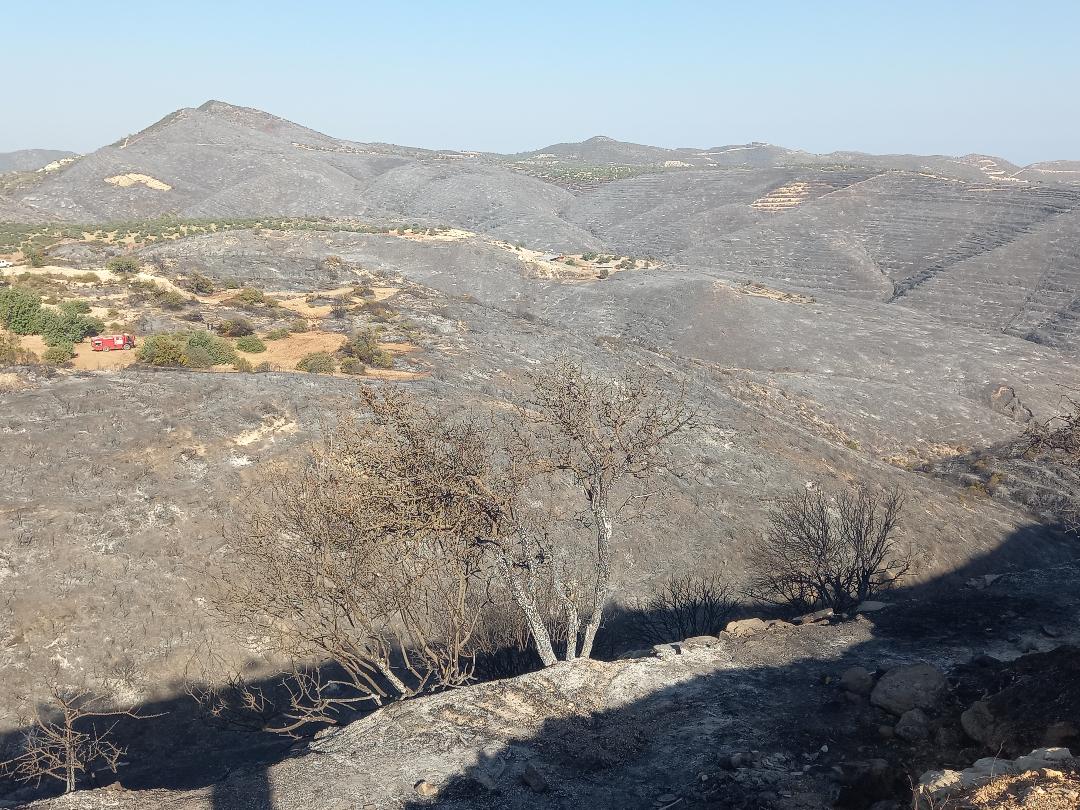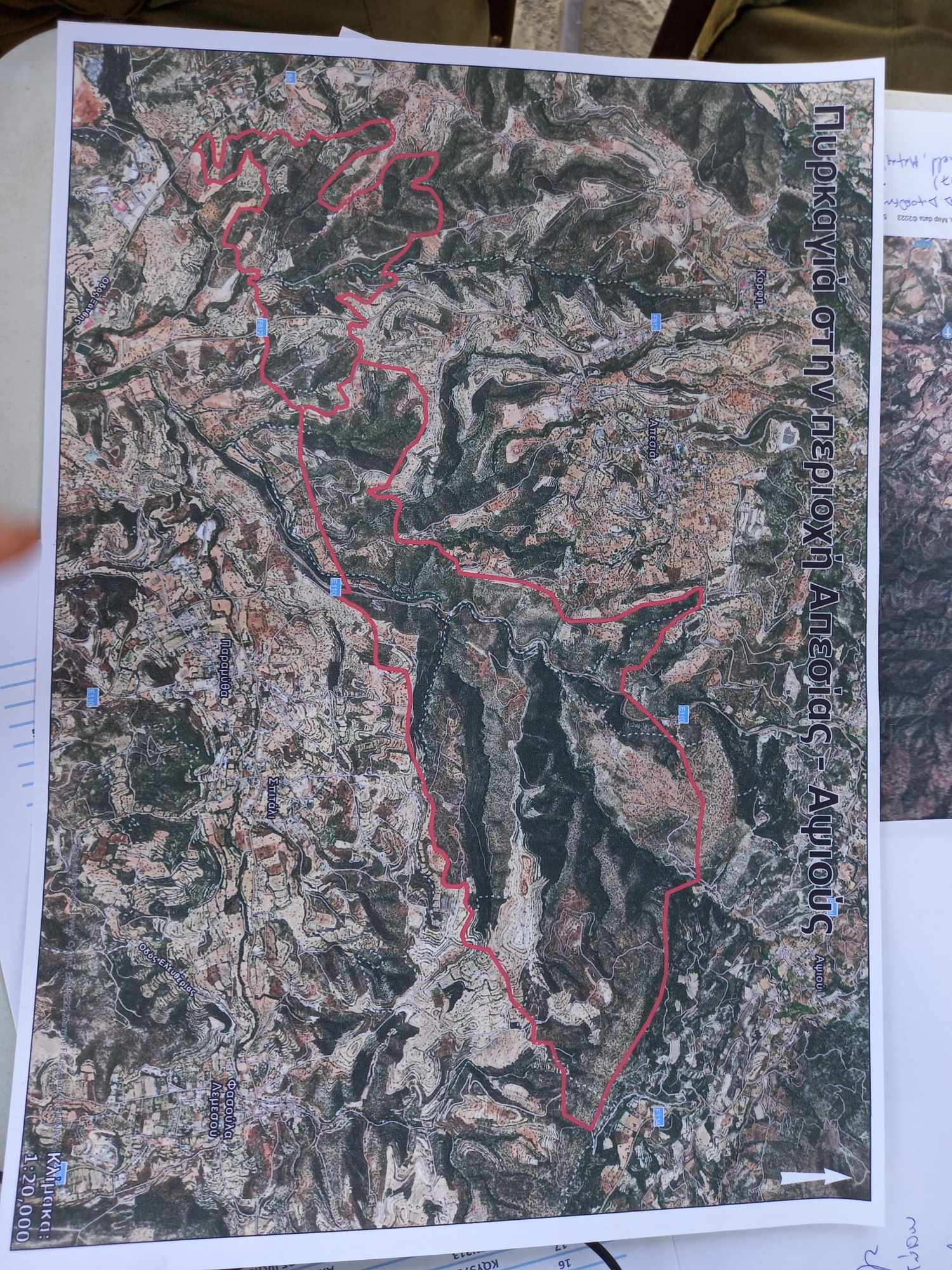
Pavlos Neophytou
The specter of the formidable Arakapa fire reawakened as an eight-and-a-half-square-kilometer blaze surged through Mountain Limassol. This time, the combined efforts of competent authorities and volunteers seem to have triumphed in safeguarding communities at risk (including Αpaisia, Paramytha, Spitali, Fasoula, Gerasa, Apsiou, and Mathikoloni), preserving human lives, and halting the destruction from extending into the Kakomallis pine forest, whose borders lie in the Apsiou community. However, this incident has also exposed certain vulnerabilities that, in the aftermath of the intense battle, are haunting the minds of citizens—particularly locals and voluntary contributors. They're seeking answers and solutions from the government. Concurrently, these events have underscored the significance of organization and preparedness among all groups of volunteer firefighters in Cyprus, particularly the local youth. Since the Arakapa disaster, their efforts have gained momentum, significantly augmenting the endeavors of competent authorities on Sunday night and Monday, providing a counterbalance alongside the shortcomings of the state apparatus.
A tangible glimpse of this dynamic emerged on Monday afternoon as we made our way to the Paramytha Coordination Centre, where Justice Minister Anna Koukkidi Prokopiou and Fire Service Chief Fire Marshal Nikos Longinos were set to brief journalists. Half a kilometer prior, near the community center, we paused to converse with a group of young individuals from Paramytha who were hastily refilling a farm car's water tank to aid in the final firefighting operations. Their tireless efforts had continued since the previous evening. All three expressed their frustration with the authorities, bombarding us with inquiries. They questioned why the Fire Department had departed the Alassa area, only for the fire to reignite shortly thereafter. They also noted delays in the authorities' return and instances where officials were observed waiting at a distance without taking action. Concurrently, as they underscored, the forest firefighters and volunteers were actively engaged in the battle.
Responses to Reinforcement and Accusations
Shortly thereafter, a bit farther down the scene, Chief Fire Marshal Nikos Longinos addressed the protests, including those of the three young individuals. In response to journalists' widespread observation of locals discussing negligence and a fire that spiraled out of control, Longinos outlined the following points:
- "The Fire Department has maintained a continuous presence since Friday and has never vacated the fire zone. It's not just the Fire Department, but all relevant agencies have been engaged."
- For this specific fire, adverse conditions, marked by strong winds, were communicated from day one. Longinos explained that they remain poised to address any incident, but at times, the prevailing conditions hinder their best efforts.
- Acknowledging the nature of major incidents, Longinos noted, "We've managed to successfully handle all situations so far, avoiding loss of life or homes. There have been some minor losses, which are unfortunately part of the scenario that can unfold."
- When queried about how the fire managed to cross over to the opposite side of the Paramytha - Agro road, the chief fire marshal elucidated, "This is a challenge we've been dealing with for years. When a fire breaches under the force of the wind, it can span up to 750 meters. If it involves multiple burners, it rapidly transitions into a spreading fire scenario, compelling us to implement our strategies."
- As for the initial fire's cause, Longinos disclosed that an investigation was underway, being handled with confidentiality. He clarified that they possess information that they have shared with the police, who have also gathered input from citizens. This data is currently under review by the police, ensuring "we arrive at accurate conclusions."
Firefighter Fatigue and Resilience
Our journey led us across the charred terrain, where in Apesia, a resident and volunteer firefighter recounted that on Sunday night, the firefighting teams appeared somewhat "numb" in the face of the encroaching blaze. They seemed to wait for the fire to draw near, while forest firefighters and volunteers engaged in fierce battles, tirelessly rushing to thwart the fire's advance toward Apaisia and Gerasa communities. Despite these observations, voices of understanding emerged, shedding light on the exhaustion weighing on the firefighters. Many had been on duty for an uninterrupted span of 30 hours.
The owner of a hypermarket in Gerasa shared their harrowing experience of nearly losing everything to the flames. However, timely intervention from the pertinent authorities, including the Forestry Department, Civil Defence, and the Fire Service, managed to safeguard the hypermarket. The owner disclosed that even when the flames briefly approached liquefied petroleum gas (LPG) cylinders, the collaboration of these agencies averted a catastrophic outcome.
Continuing our journey towards Paramytha, we conversed with two hotel proprietors who had animals under their care. They expressed gratitude for the authorities' swift response, which effectively prevented unfavorable circumstances. In one instance, minor damage prompted volunteers to relocate dogs and cats to a facility in Limassol. Volunteers of the "KitasWeather" Team in Apaisia, on patrol for any resurgences.
Volunteers of the "KitasWeather" Team in Apaisia, on patrol for any resurgences.
Water Scarcity, Road Accessibility, and Supplies
In both Apaisia and Apsiou, a pressing concern emerged over the scarcity of water for firefighting during the nighttime battle against the blaze. Appeals are being directed toward the state to ensure the provision of ample water resources for communities grappling with such colossal fires. The demand is for expanded irrigation and water supply initiatives, along with increased water storage tanks. The communities express their gratitude for volunteers hailing from other regions, even from distant locales like Geroskipou, who lent their support by ferrying water during the trying hours. In Apsia, locals turned to social media for water assistance, yielding a robust response. Concurrently, they emphasize that the absence of sufficient water resources within communities is inconceivable.
During the outbreak of the fire in Apsiou, a situation arose where water extracted from a source sufficed for a single filling of a water carrier. Moreover, in Apsiou, the issue of inadequate rural roads hindered the proximity of firefighting vehicles to the fire fronts. Another challenge, as highlighted by sources in Apsiou, was the noteworthy delay by the Provincial Administration in supplying sustenance to the personnel battling the flames on Sunday night. This was attributed to an apparent lack of effective coordination. In this context, commendation was bestowed upon a volunteer who distributed sandwiches to those at the forefront of the fire that night. A map of the Department of Forests depicting the extent of the large fire was obtained by "K". Apparently, the resurgence started from the west (Alassa) and progressed to the east, in an area of 8.5 square kilometers.
A map of the Department of Forests depicting the extent of the large fire was obtained by "K". Apparently, the resurgence started from the west (Alassa) and progressed to the east, in an area of 8.5 square kilometers.
The Damage
Limassol District Administration crews meticulously documented the property damage inflicted by the firestorm's path. According to Marios Alexandrou, within the Apaisia community vicinity, a disused residence was utterly devastated, alongside a warehouse and two stationary vehicles. Similarly, in Paramytha, a vacant auxiliary structure was reduced to ashes. The assessment further unveiled that a dog shelter suffered minor damage, and a limited number of stationary vehicles and drill bays were incinerated. In Apsiou, the fire engulfed a cottage, razed two livestock units, and destroyed storage sheds.
[This article has been translated from its original Greek version and may not fully capture the exact 'feeling' or tone present in the original text.]
































